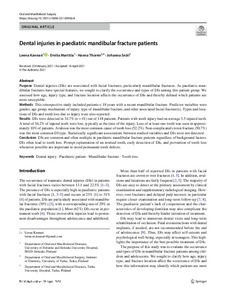Dental injuries in paediatric mandibular fracture patients
Thorén Hanna; Marttila Emilia; Snäll Johanna; Kannari Leena
Dental injuries in paediatric mandibular fracture patients
Thorén Hanna
Marttila Emilia
Snäll Johanna
Kannari Leena
SPRINGER HEIDELBERG
Julkaisun pysyvä osoite on:
https://urn.fi/URN:NBN:fi-fe2021093048611
https://urn.fi/URN:NBN:fi-fe2021093048611
Tiivistelmä
Purpose Dental injuries (DIs) are associated with facial fractures, particularly mandibular fractures. As paediatric mandibular fractures have special features, we sought to clarify the occurrence and types of DIs among this patient group. We assessed how age, injury type, and fracture location affects the occurrence of DIs and thereby defined which patients are most susceptible. Methods This retrospective study included patients < 18 years with a recent mandibular fracture. Predictor variables were gender, age group, mechanism of injury, type of mandibular fracture, and other associated facial fracture(s). Types and locations of DIs and tooth loss due to injury were also reported. Results DIs were detected in 34.7% (n = 41) out of 118 patients. Patients with tooth injury had on average 3.5 injured teeth. A total of 16.2% of injured teeth were lost, typically at the time of the injury. Loss of at least one tooth was seen in approximately 10% of patients. Avulsion was the most common cause of tooth loss (52.2%). Non-complicated crown fracture (50.7%) was the most common DI type. Statistically significant associations between studied variables and DIs were not detected. Conclusion DIs are common and often multiple in paediatric mandibular fracture patients regardless of background factors. DIs often lead to tooth loss. Prompt replantation of an avulsed tooth, early detection of DIs, and prevention of tooth loss whenever possible are important to avoid permanent tooth defects.
Kokoelmat
- Rinnakkaistallenteet [19207]
